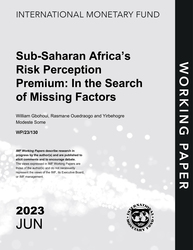
Sub-Saharan Africa’s Risk Perception Premium: In the Search of Missing Factors
Sub-Saharan Africa’s Risk Perception Premium: In the Search of Missing Factors
READ MORE...
Volume/Issue:
Volume 2023
Issue 130
Publication date: June 2023
ISBN: 9798400242144
$20.00
Add to Cart by clicking price of the language and format you'd like to purchase
Available Languages and Formats
| English |
Prices in red indicate formats that are not yet available but are forthcoming.
Topics covered in this book
This title contains information about the following subjects.
Click on a subject if you would like to see other titles with the same subjects.
Banks and Banking , Investments and Securities-General , Economics- Macroeconomics , Economics / General , perception premium , SSA country , policymakers from the sub-Saharan Africa , SSA premium , IMF WP 23/130 , c , robustness , Return on investment , Sovereign bonds , Yield curve , Bonds , Sub-Saharan Africa , Global , Africa
Also of interest
Summary
Policymakers from the sub-Saharan Africa (SSA) region often flag a mispricing of their sovereign debt presumably originating from a perception risk by international investors that lead to "unjustifiably" high borrowing costs. Against this background, this paper explores the extent to which a potential SSA premium exists in the financial markets following a broader two-fold approach. Firstly, using a sample of 1592 international primary sovereign fixed coupon bonds issued between 2003-2021 from Bond Radar by 89 countries, we find that SSA countries pay significantly higher coupon at issuance compared to their peers from other regions. Secondly, we assess whether there is any bias against SSA countries in the secondary market that would result in higher refinancing cost. Based on an unbalanced panel of quarterly data covering 107 countries over 1990 – 2022, we find that SSA countries pay higher refinancing costs in the secondary market. The paper further explores whether there are other factors overlooked by the literature that matter for the risk pricing by international investors. In that respect, we explore the sensitivity of spreads to some structural dimensions where SSA countries face acute challenges―the transparency of budget process, the importance of the informal sector, the level of financial development, and the quality of public institutions. The results show that the excess premium estimated for SSA countries vanishes when these structural factors are accounted for in the regressions.
Copyright © 2010 - 2025
Powered by:
AIDC



